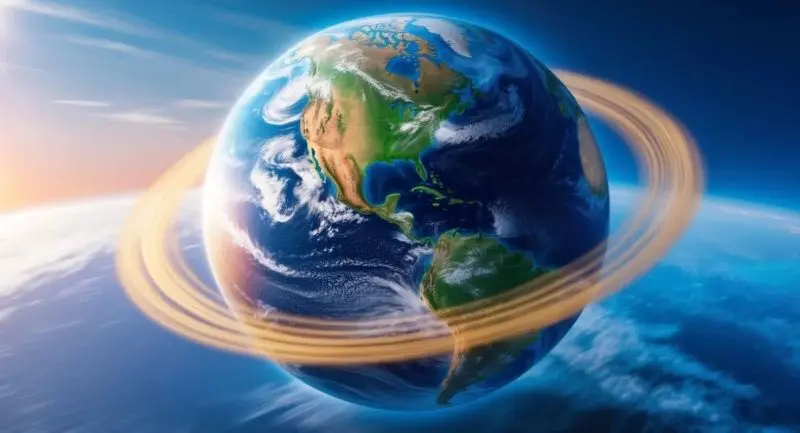Every day, Earth completes a full rotation on its axis, resulting in day and night. But did you know that Earth’s rotation isn’t perfectly uniform? On some days — such as July 9 — scientists have observed measurable variations in how fast or slow Earth spins. Though these differences are just milliseconds, they have huge implications for satellites, GPS, and timekeeping.
Table of Contents
- Introduction: The Daily Spin of Our Planet
- What Is Earth’s Rotation?
- What’s Special About July 9?
- Causes of Earth’s Rotational Variations
- How Scientists Measure Earth’s Rotation
- What Is a Leap Second, and Why It Matters
- Will July 9 Keep Breaking Records?
- Final Thoughts: Why Earth’s Rotation on July 9 Matters
- References and Sources
Introduction: The Daily Spin of Our Planet
Earth spins once every 24 hours, causing the cycle of day and night. But this rotation isn’t perfectly consistent. Variations — even tiny ones — can have ripple effects on our technology and understanding of planetary science. In this article, we look at why July 9 stands out and what it reveals about Earth’s dynamics.
What Is Earth’s Rotation?
Earth’s rotation refers to the spinning of the planet on its axis. A complete rotation takes about 23 hours, 56 minutes, and 4.1 seconds — a sidereal day — though our solar day (sunrise to sunrise) is about 24 hours.
- Earth rotates from west to east.
- At the equator, Earth moves at ~1,670 km/h (1,038 mph).
- The rotation causes the day-night cycle and affects wind patterns and ocean currents.
What’s Special About July 9?
On July 9, 2022, Earth recorded one of its shortest days ever, spinning faster than average. It completed a full rotation 1.5 milliseconds faster than the standard 86,400 seconds.
While June 29, 2022, still holds the record for the shortest day, July 9 was part of a pattern of rapid rotational fluctuations noticed by scientists. These micro-changes are measured using atomic clocks and can impact everything from GPS to international timekeeping systems.
Causes of Earth’s Rotational Variations
1. Tidal Forces from the Moon
The Moon’s gravity pulls on Earth’s oceans, creating tides. This tidal interaction gradually slows Earth’s rotation, lengthening days by about 1.7 milliseconds per century.
2. Atmospheric and Oceanic Currents
Weather systems like jet streams and El Niño can shift mass across the planet, subtly affecting rotational speed. For instance, strong winds in the stratosphere can slightly accelerate Earth’s spin.
3. Earthquakes and Glacial Rebound
Major earthquakes — like the 2004 Indian Ocean quake — redistribute Earth’s mass, affecting its moment of inertia. Post-glacial rebound (land rising after ice melts) also plays a role.
4. Climate Change and Polar Ice Melt
As ice melts from polar regions and flows toward the equator, it can make Earth spin slightly faster. This is similar to how a figure skater spins faster when they pull their arms inward.
How Scientists Measure Earth’s Rotation
Earth's rotation is tracked using:
- Atomic clocks (extremely precise)
- VLBI – Very Long Baseline Interferometry
- Laser ranging to satellites and the Moon
- Global Positioning Systems (GPS)
Agencies like the International Earth Rotation and Reference Systems Service (IERS) and NASA monitor rotation daily to inform leap second adjustments.
What Is a Leap Second, and Why It Matters
When atomic time and Earth’s actual rotation drift apart, we add or subtract a leap second to stay in sync. All past leap seconds have been positive (added), but with Earth’s recent acceleration, we might need to subtract a second in the near future.
Leap seconds impact:
- Global timekeeping (UTC)
- Telecommunication networks
- Stock exchanges
- Scientific research and simulations
Will July 9 Keep Breaking Records?
It’s hard to predict. Earth’s rotation is influenced by multiple variables — natural and human-induced. Some scientists expect more ultra-short days in coming years, while others believe these changes may even out over time.
Final Thoughts: Why Earth’s Rotation on July 9 Matters
July 9 is a reminder that Earth is not a perfect machine. Its rotation fluctuates slightly — and understanding these changes is essential for managing modern technologies and studying our climate. Tiny variations in time today could help us predict bigger changes tomorrow.
References and Sources
Leave a comment
Your email address will not be published. Required fields are marked *


